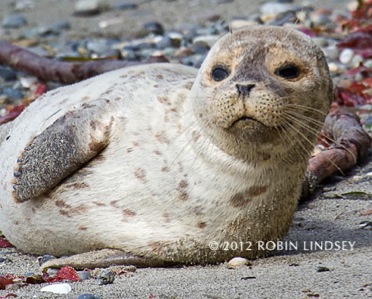Apr 2012
May volunteer training date set
Apr/28/12 08:23 PM
Seal Sitters will hold our last training of the year on Saturday, May 19th from 10am-12:30ish. The location of the event will be announced at a later date. Pupping season in South Puget Sound begins in mid-June in area rookeries, where pups are born and nursed for 4-6 weeks. We don’t usually begin seeing pups on West Seattle beaches until early July with the peak of our season in September and October. All of the pups we have been seeing the past few months are weaned pups from last season. Please mark your calendar and check back for updates. RSVP if you would like to attend the training.
Pupping season has begun on the outer coast of Washington. If you visit coastal areas, you may encounter a pup alone on the beach. Please observe from a distance and keep people and dogs away. If you have concerns about the health or safety of the pup, please call the stranding network for that area. If you don’t have access to the internet from your phone, you can always call the Seal Sitters hotline at 206-905-SEAL (7325) for the appropriate number.
Pupping season has begun on the outer coast of Washington. If you visit coastal areas, you may encounter a pup alone on the beach. Please observe from a distance and keep people and dogs away. If you have concerns about the health or safety of the pup, please call the stranding network for that area. If you don’t have access to the internet from your phone, you can always call the Seal Sitters hotline at 206-905-SEAL (7325) for the appropriate number.
"Easter seal" keeps volunteers hopping on sunny holiday
Apr/11/12 05:35 AM

Divers recover seal pup Sandy's body for necropsy
Apr/05/12 09:49 PM
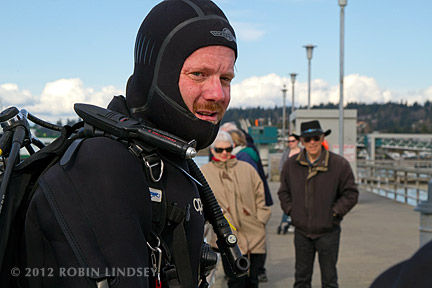
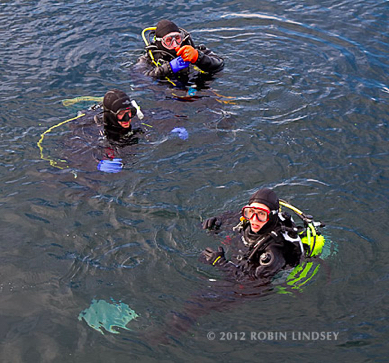
Yesterday, while the MaST team searched the cold waters below (photo right), Seal Sitters’ lead investigator was stationed up on the pier to keep them safe from fishermen’s casts. She had an enlightening conversation with lone fisherman Nick about derelict lines and lures. According to Nick, there are a number of large tires that have been sunk off the pier in order to create habitat for fish. While fish have indeed become abundant in this habitat, the problem is that lures are constantly getting caught on the rubber tires and fishermen can’t reel them back in. Much to the frustration of the fishermen, the lines then have to be cut, leaving a maze of ebbing monofilament, hooks and lures which put marine mammals and sea birds at great risk. Nick said that Des Moines had sunk tires as well years ago, but finally removed them all. It was his and other fishermen’s opinion that Edmonds should follow suit. When the MaST team completed the dive, Sandy in tow, the divers mentioned the amazing amount and variety of large game fish in the habitat - and where there are big fish, there are usually the small bait fish that seal pups prefer.
While the Edmonds pier situation appears irreparable without removal of the tire habitat, Seal Sitters has noticed that the fishing piers in West Seattle (Water Taxi and Duwamish Head piers) are often strewn with cut line and hooks. There are a number of sea gulls seen by the piers with only one leg - the direct result of having line sever a leg. Volunteers David and Eilene recently removed line from the leg of a gull. Lincoln Park’s favorite fishing hole by Colman Pool is littered with line and hooks everywhere when the fish are running. We respectfully ask that fishermen please be more careful and not leave derelict gear. Not only are seal pups and gulls endangered - so are people and other animals.
Huge thanks to MaST’s stranding team Rus, Kaddee and Arthur for recovering “satellite” Sandy, whose movements were followed by almost 600 residents of Puget Sound via her SeaDoc Society dedicated web page. The satellite revealed that Sandy travelled 990 kilometers (615 miles) in the 66 days she swam free in the wild. The death of Sandy has truly put a face on the dangers of marine debris and derelict fishing gear. Seal Sitters intends to dedicate our annual beach cleanups in her memory. We hope you will join us.
Derelict fishing gear dangers - and what to do
Apr/03/12 01:37 PM
The death of seal pup Sandy, who drowned entangled in fishing line, has raised many questions the past two days. People have been asking what to do about derelict fishing gear should they come upon it. First of all, derelict gear, especially line and nets, is extremely dangerous. Never get close enough to risk becoming entangled yourself. Northwest Straits Derelict Gear Removal Program has informed us that a diver became entangled and died during a fishing line recovery operation several years ago.
If by sad chance, you see a dead marine mammal entangled in gear, get a photo if possible. If the animal is tagged and you can do it safely, try to get a photo of the tag number. Do not put yourself in danger to do so. Do not attempt to remove the animal or the fishing gear. Email the photo of the animal to Kristin Wilkinson, NOAA’s NW Marine Mammal Stranding Expert, along with lat/long information. To report only derelict gear, please contact NW Straits - they are the experts at removal.
What should you do if you encounter a live entangled animal? First, if at all possible, call the NOAA stranding network @ 800-853-1964 (in the West Seattle area call 206-905-7325). Keep in mind that most of the networks do not have boats or divers readily available for that type of response except in matters of whales. We want to stress the inherent danger in trying to free an animal. If you insist on proceeding at your own risk in this highly dangerous task, NOAA’s Good Samaritan clause will protect you from Federal prosecution for the “take” of a marine mammal (Marine Mammal Protection Act). The Good Samaritan exemption is as follows (found on NOAA website):
It shall not be a violation of this chapter to take a marine mammal if:
1) such taking is imminently necessary to avoid serious injury, additional injury, or death to a marine mammal entangled in fishing gear or debris
2) reasonable care is taken to ensure the safe release of the marine mammal, taking into consideration the equipment, expertise and conditions at hand
3) reasonable care is exercised to prevent any further injury to the marine mammal and
4) such taking is reported within 48 hours
Please note: This MMPA exemption does not protect you from liability of monetary damages from the owner of the net or fishing gear.
We cannot say enough how tremendously dangerous fishing gear is to all living things - including you. The last thing we want is a human tragedy on top of this environmental one.
If by sad chance, you see a dead marine mammal entangled in gear, get a photo if possible. If the animal is tagged and you can do it safely, try to get a photo of the tag number. Do not put yourself in danger to do so. Do not attempt to remove the animal or the fishing gear. Email the photo of the animal to Kristin Wilkinson, NOAA’s NW Marine Mammal Stranding Expert, along with lat/long information. To report only derelict gear, please contact NW Straits - they are the experts at removal.
What should you do if you encounter a live entangled animal? First, if at all possible, call the NOAA stranding network @ 800-853-1964 (in the West Seattle area call 206-905-7325). Keep in mind that most of the networks do not have boats or divers readily available for that type of response except in matters of whales. We want to stress the inherent danger in trying to free an animal. If you insist on proceeding at your own risk in this highly dangerous task, NOAA’s Good Samaritan clause will protect you from Federal prosecution for the “take” of a marine mammal (Marine Mammal Protection Act). The Good Samaritan exemption is as follows (found on NOAA website):
It shall not be a violation of this chapter to take a marine mammal if:
1) such taking is imminently necessary to avoid serious injury, additional injury, or death to a marine mammal entangled in fishing gear or debris
2) reasonable care is taken to ensure the safe release of the marine mammal, taking into consideration the equipment, expertise and conditions at hand
3) reasonable care is exercised to prevent any further injury to the marine mammal and
4) such taking is reported within 48 hours
Please note: This MMPA exemption does not protect you from liability of monetary damages from the owner of the net or fishing gear.
We cannot say enough how tremendously dangerous fishing gear is to all living things - including you. The last thing we want is a human tragedy on top of this environmental one.
Seal pup Sandy drowns in fishing gear
Apr/01/12 07:52 PM
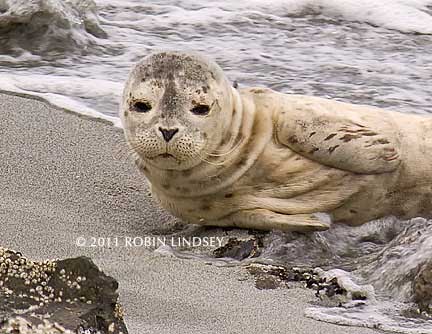
Sandy was only three weeks old, weighing 7.1 kgs (a third of normal body weight for a nursing pup), when she was rescued by Seal Sitters from a West Seattle beach on August 15, 2011 (photo right). She spent a lengthy 5 month rehab at PAWS, but was a robust pup when finally released at a harbor seal rookery in South Puget Sound. Through the combined efforts of PAWS, NOAA, SeaDoc Society and WDFW Marine Mammal Investigations, Sandy was fitted with the satellite tag in order to provide valuable data to researchers. The satellite revealed she stayed relatively close to the release point for the first few days, but then she began taking off on adventures - south to Olympia, north to the San Juans, circling Vashon, back to Olympia and Shelton, up to Edmonds a couple of times. After being in a small pool for so many months, it seemed as though she had the travel bug and appeared to be thriving in the wild (map below shows her travels). The last satellite hit was on the 27th.
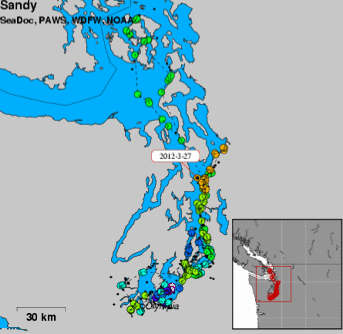
Sandy is not the only harbor seal with a West Seattle connection to die from fishing gear. A few days before we rescued her last August, we responded to a dead adult female on Beach Drive. The necropsy showed that the female had given birth within ten days or so and the cause of death was from fishing line and lure, twisting the female’s stomach and causing an agonizing death. A newborn pup we nicknamed Tiny died on another beach the same day as the necropsy. It is not beyond the realm of speculation that Tiny was this female’s pup and that fishing gear caused the death of both animals.
This is truly a very sad day. Special thanks to PAWS’ staff who nursed Sandy back to health and cared for her for so many months. For those of us who participated in her release, we will never forget the joy of seeing her swimming free in the Sound with that little yellow-green satellite hat. SS volunteers and Puget Sound residents signed up to receive SeaDoc Society email alerts and excitedly followed her movements online. To read more about Sandy and view the video of her release back to the wild, click here.
To learn more about the dangers of marine debris and how you can help, click here.
NOTE TO DIVERS:
If you are a diver and come upon animals who have died in derelict gear, we ask two things. First, please take a photograph and email a jpg to us. We will forward the photos to the appropriate person for a corresponding database - this will greatly help assess the true number of animals that perish each year. Secondly, please indicate the location of the derelict gear if you have lat/long finder and we will report it to the Northwest Straits Derelict Fishing Gear Removal Program which estimates that 50,000 animals are entangled and die each year in Washington waters just in shallow water nets and gear (excluding an unknown number in deep-water derelict gear). Harbor seals had by far the highest number of deaths among marine mammals in gear they removed. According to their website :
As of November 30, 2011, the Northwest Straits Initiative has removed 4,081 derelict fishing nets and 2,668 crab pots from Puget Sound, restoring 596 acres of critical marine habitat. Over 241,700 animals, representing more than 240 species, were found entangled in this gear.
Please spread this message among your diving community and make a difference for the marine mammals of Washington. Do not attempt to remove fishing gear - it is extremely dangerous. NW Straits has informed us that a diver drowned in Puget Sound a few years ago on a sport fishing line cleanup.
Sunny day brings pup and outreach
Apr/01/12 11:39 AM

